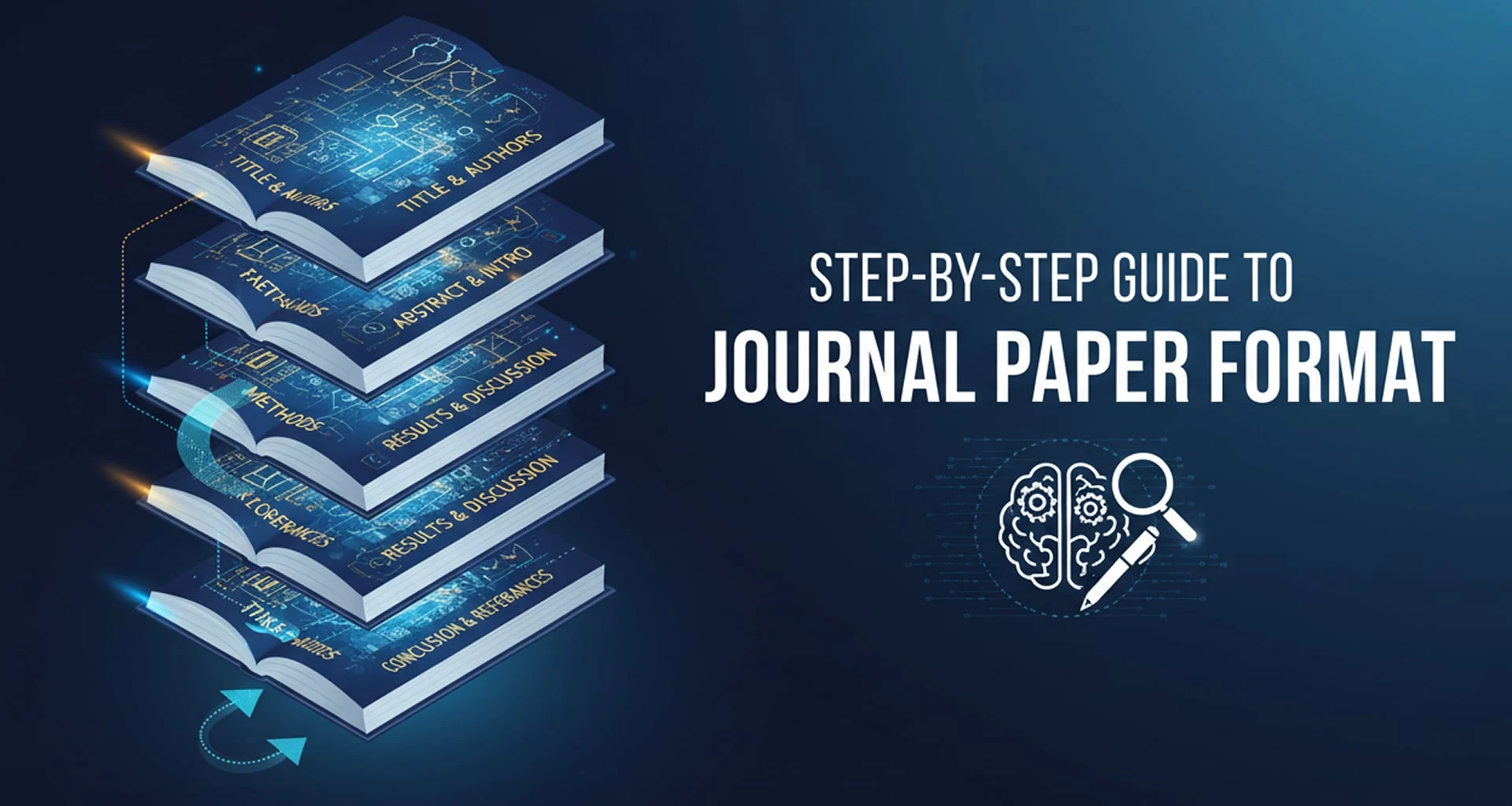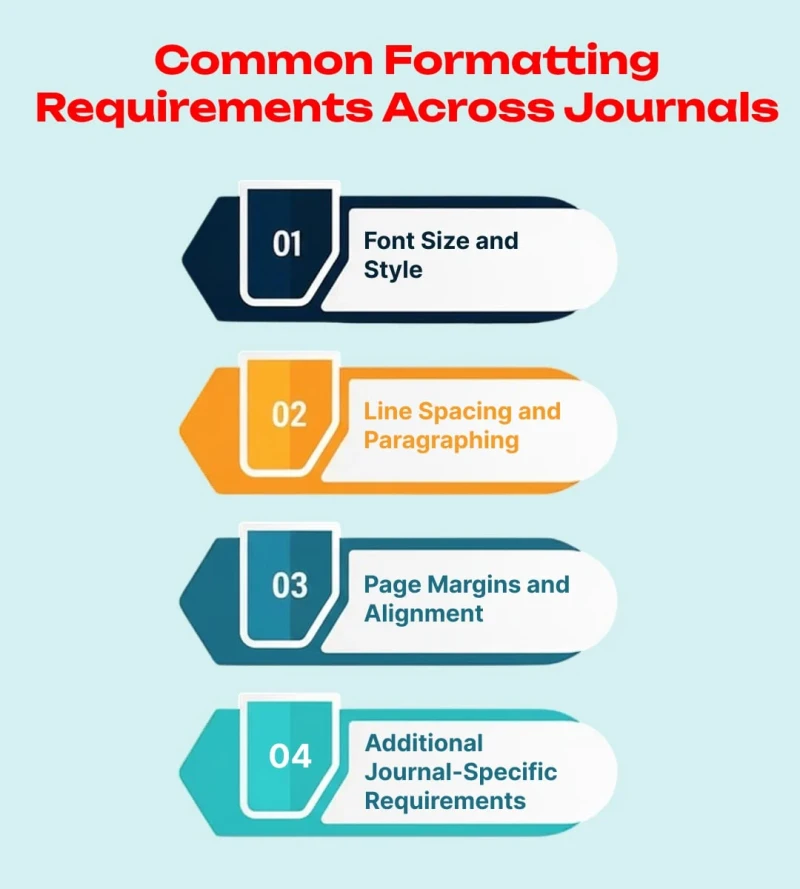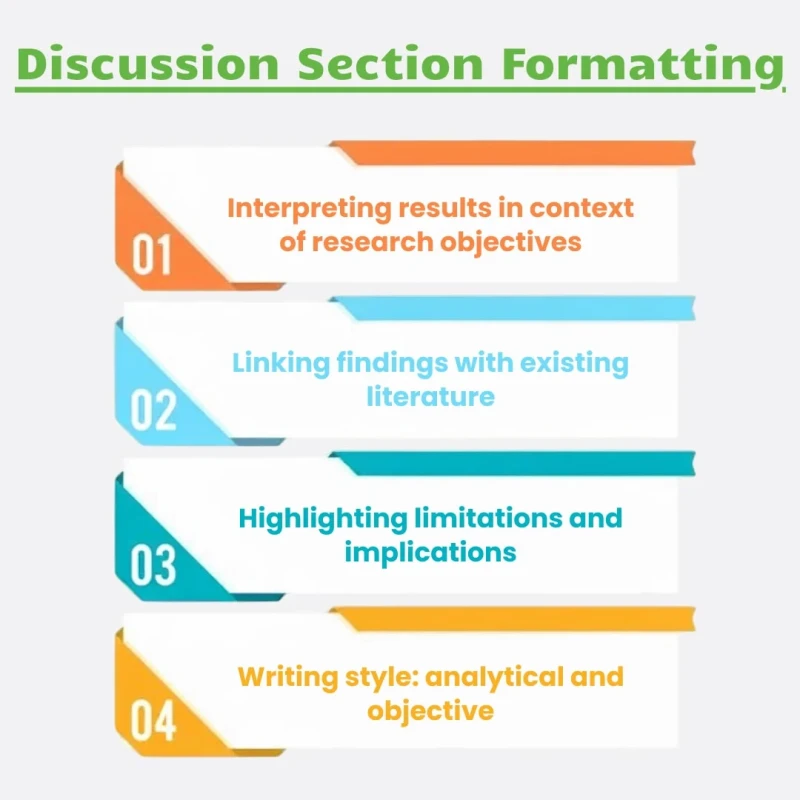
Emilia
A well-structured journal paper format is not just a writing template; but it is the foundation of academic ethics. As long as your research follows the correct layout, it communicates ideas in an efficient manner, becomes publication-ready, and gains the best opportunities of getting published in elite journals.
This blog provides a step-by-step description to clarify the needed sections, the rules of formatting, and the presentation needs of an elite journal paper. By the end, you’ll know exactly how to format your paper to meet international publishing expectations and impress reviewers.
A journal paper format sets the standardised framework, layout, and presentation style that researchers are to adhere to for the sake of academic clarity, coherence, and publication readiness by professionals.
It establishes a single framework for title, abstract, methodology, results, and references, so your research meets editorial and peer-review requirements.
Once you understand the purpose of a journal paper format, the next step is knowing the common formatting standards followed across major journals.

Each scholarly journal publishes its own checklist of formatting, but a few needs are universally recognised. These bring coherence, readability, and ease of examination. The most frequent components of a journal paper format, in the main areas, are listed below.
Font selection is essential for readability and professionalism.
Times New Roman or Arial for the text body is the standard recommended by most journals.
The standard font size is 12-point for regular text and 10-point for footnotes, tables, and figures.
Use a consistent font type and size throughout the manuscript.
Steer clear of fancy or non-academic fonts; simplicity guarantees that your work appears credible and easy to read.
Appropriate spacing ensures your paper is neat-looking and easy to read.
The standard practice is double spacing throughout the manuscript, including references and captions.
Single spacing can be applied in tables, figures, and block quotations.
Keep consistent paragraph indentation (usually 0.5 inches).
This spacing offers sufficient space for reviewers to leave comments and looks neat when printed or saved to PDF.
Margins control the balance and legibility of your content layout.
Default margin settings are 1 inch (2.54 cm) on all four sides.
Text must be ragged right (left-aligned) and not fully justified to enhance readability.
The same consistent margins must be kept for tables, charts, and figures as well.
Different margin specifications for online submission through journals like ScholarOne or Elsevier Editorial Manager might be demanded, so always double-check before the final submission.
Headers and footers with page numbers may also be required by some journals.
Figures and tables must be captioned and in-text cited.
Title page with author affiliations, ORCID ID, and details of the corresponding author.
Word count restrictions for abstracts and full text (usually stated in author guidelines).
The details differ slightly between journals, but by following these basics, your journal paper will have universal academic standards.
Before starting your manuscript, there needs to be clarity regarding your journal's readers and requirements. These initial stages keep your writing at academic and editorial par.
Adequate selection of journals is the bedrock of publication success. Read the journal's aims, scope, and formatting requirements before writing to ensure that your paper is satisfactory for it. Pre-emptive adaptation to journal requirements saves submission time and minimizes rejection potential.
Journals set submission guidelines for format, word count, and file type. Ignoring these often leads to desk rejection without peer review, while adherence demonstrates professionalism and respect for editorial standards.
Your journal article begins with a good title and abstract, the initial readers and reviewers to read. Both of them must encapsulate the essence of your research in simple and concise language.
Your title must articulate the essence of your study's central argument in the fewest possible words.
Be brief and descriptive, and not full of jargon and acronyms.
Highlight significant variables or research interest issues.
Make sure that your title is concise to 10–15 words to make it readable and comprehendible.
Don't use "A Study on Water Quality," and instead use "Assessment of Groundwater Quality Using GIS-Based Analysis."
Your paper's initial impression is a well-written title. Your research field needs to be made clear, and the correct academic community approached at once.
Keywords make your paper indexed in scholarly databases and discoverable.
Select 4–6 keyword topics relevant to your research topic and breadth.
Put your master keyword at the beginning or near the end of your list.
Do not put duplicate keywords in your title.
Use semicolons or commas, as your journal suggests.
Prioritizing keywords enhances web findability of your research paper. Use them well to satisfy your journal paper requirements and indexing guidelines.
An abstract is a short summary of your research, typically ranging from 150 to 250 words. It needs to quickly mention the background, the methods, the important outcomes, and the main conclusion, so that readers get the essence of your research without going through the complete paper.
Do not include references, use any technical languages, or make overblown statements. A good abstract helps readers understand your work very clearly and it also influences the way the readers perceive the whole paper
Introduction is where you set the premise for your study. A proper introduction in a journal paper format should clearly define the study problem, its relevance, and the purpose of the study.
Introduction sets context and basis for your research. It should:
Provide background to the issue.
Clarify gaps in knowledge that already exist.
Illustrate why the research is needed and how it is a contribution to the area of study.
Making your study purpose clear evokes reader interest and credibility. It positions your work as an added-value contribution to scholarship.
A common format for a professional journal paper introduction is having this sequence:
Background: Briefly summarize previous work that is already done.
Problem Statement: Identify the main research question or problem.
Research Gap: Demonstrate what is lacking and how your contribution fills it.
This structured sequence informs people why your work matters and is innovative.
By depicting the gap and research problem, you are describing the significance of your research to the discipline. This helps to increase your broader scholarly significance in the paper.
End your introduction by clearly stating your research objectives or hypotheses. This helps reviewers see how your study builds on existing literature and defines its direction.
A hypothesis is a testable prediction drawn from your research problem, while an objective defines what your study aims to achieve.
Example:
Objective 1: To examine how digital learning tools influence students’ long-term knowledge retention in higher education.
Objective 2: To assess whether learner engagement mediates the relationship between digital tool usage and academic performance.
—or—
Hypothesis 1: Increased use of interactive digital platforms leads to higher knowledge retention among university students.
Hypothesis 2: Learner engagement significantly mediates the effect of digital platform usage on academic performance.
There needs to be a systematic literature review so that whatever type of a journal paper you are composing is logical and academically sound. It is the backdrop upon which you develop your research, demonstrates you to be familiar with existing research, and articulates the knowledge gap upon which your paper will provide illumination.
For additional information, you can also view our detailed literature review blog for more advanced guidance and samples.
When structuring your literature review, take on a logical framework from general context to specific focus areas.
Start out by presenting the general research context and general trends.
Gradually narrow down to broad studies and research outcomes pertinent to your area of study.
Finish by mentioning the research gap and how your research fills this research gap.
Clarity of structure makes your writing easier to read and signifies the academic value of your research.
Originality is the basis of ethical writing in any journal paper format.
Always credit sources for ideas, data, or concepts.
Make use of plagiarism detection devices to ensure authenticity.
Put an emphasis on analysis and synthesis instead of repetition.
Holding on to originality ensures your paper is of the highest ethics of publication and will gladly stand editorial review.
Your literature review should be a flowing link from wide context to the focused research concern.
Begin with macro-research directions and unfold step-by-step towards concerted, topic-specific conclusions.
Employ flow words to welcome the reader into your argument.
Summarize by relating any previous literature to your research hypotheses or goals.
Remaining logical and sequential in writing keeps readers interested and highlights how your research fills existing gaps.
Your methodology section is the centerpiece of your journal paper structure because it outlines in detail how research was set up and conducted. It provides other researchers with the ability to test or replicate your findings. To get more information about research and examples, refer to our blog on research methods.
Place this section under clear subheadings for easy reading:
Participants: Specify the sample size, selection criteria, and demographics.
Data Collection: State how data were collected—surveys, interviews, experiments, or archival records.
Tools and Instruments: Enumerate equipment, software, or analysis tools utilized.
Procedures: Explain every step of your research clearly step by step.
Clearly written subsections make things obvious and enable readers to track your step-by-step process of study.
Ensure your methodology is detailed enough for replication and include visuals only when they clarify complex steps.
The results section presents your findings correctly and appropriately, in the manner you've created your journal paper outline. The results section is what you've discovered word for word, and not what you interpret it to mean—save this for the discussion section.
Organize findings in the same sequence as research questions or hypotheses.
Use brief subheadings for major findings.
Do not repeat and be concise.
Proper presentation makes your findings simple to understand and remember later on.
Prolonged use of graphics is employed to abbreviate extensive data.
Minimize use of a figure or a table only where absolutely needed.
Use identifying titles and number them continuously.
Number the table or figure in the text.
Properly formatted images make your data presentation accurate, clear, and to the point.

The discussion section situates your results in the context of your research goals and in the greater good of scholarship. Journal writing, this is where you declare the significance, meaning, and limitation of your research.
Interpretation of Results in Context of Research Goals
Declare what your results are and how they relate to your research goals.
Highlight whether your results support or refute your hypotheses.
Give theoretical or practical explanations.
Contextual accounts inform readers about how your findings are relevant to education or daily life.
Relate your outcomes to earlier studies that are the focus of your literature review.
Identify extensions, contradictions, or similarities.
Explain why your research is a continuation of the work already done.
Paraphrasing earlier work in describing relationships is evidence of scholarship and maturity.
Report methodological or environmental limitations.
Explain implications for theory, practice, or future research.
Provide guidance for future research.
Admission of limitation while highlighting contribution adds credibility and objectivity to your argument.
Conclusion is the final but most critical section of your journal paper format, capturing your research findings and what they imply. It takes closure while informing readers on the contribution of the study and where it will proceed from.
Identify what makes your study worth reading to academics.
Describe how your study adds to the literature.
Make a claim on theoretical, methodological, or practical contributions.
Be confident but impartial.
Emphasizing contribution presents additional scholarly merit and value to your paper.
Suggest gaps or challenges yet to be solved.
Invite replication researchers or research along a longer path in other settings.
Discuss briefly and practically as recommendations.
Prognostic recommendations illustrate scholarly maturity and invite further scholarly work.
Good citation is a part of any journal article layout, citing previous work and adhering to publication norms. Good citation also gives your work added credibility and moral authority.
Use them properly and consistently in the text.
Proper in-text citations clearly indicate transparency and lend credibility to your arguments.
Format Reference List or Bibliography
Put your list of references at the end of your essay, as per the citation style adopted.
Arrange the entries alphabetically or numerically, as the case may be.
Make sure there is even indentation, punctuation, and spacing.
Double-check all the citations with care.
Professionalism and readability are enhanced with an orderly bibliography.
Do not spend time doing it manually with reference management tools like Mendeley, Zotero, or EndNote.
They sort and format the citations automatically.
Integration with word processing to allow for inserting citations.
Electronic tools minimize formatting errors and simplify citation management.
Tables, figures, and supplementary materials enhance your journal paper layout by providing information in visual format and enhancing descriptive text that would otherwise be lengthy. They also have to contend with rigid rules regarding positioning and formatting.
Number and title each table and figure with clear, concise captions.
Maintain sequential numbering throughout the manuscript.
Cross-reference each table or figure in the text and explain its relevance.
Brief cross-referencing and captioning serve to build clarity and allow readers to match words to images.
Supplementary files provide your paper more support in the form of more information or information.
Use appendices for elaborate methodologies or extensive data tables.
Give datasets or code as separate additional files if permitted.
Label them clearly so that they can easily be identified.
Supporting materials provide highest transparency and allow readers to view your research in detail.
Many papers face rejection not because of poor research, but due to careless formatting. Consistency and structure are what make a manuscript look credible and professional.
Keep your headings and subheadings organized and aligned with journal standards.
Stick to one citation style APA, MLA, Vancouver, or Chicago and apply it uniformly.
Don’t crowd your abstract or discussion with unnecessary explanations or data.
Check your target journal’s author guidelines before final submission; small oversights can cost acceptance.
Avoiding these mistakes ensures your paper is clear, compliant, and publication-ready.
Following a correct journal paper format is not just a matter of aesthetics—it embodies academic rigor, moral quality, and consideration for the publishing process. Every part, starting from the title and ending with references, has its own uniqueness in proper communication of your research with clarity and trustworthiness.
In case you are in doubt about compliance with the standards of formatting or submission, the assistance of professionals in editing can be time-saving, rejection risk-lowering, and paper-improving to the extent of the standards required by leading journals.